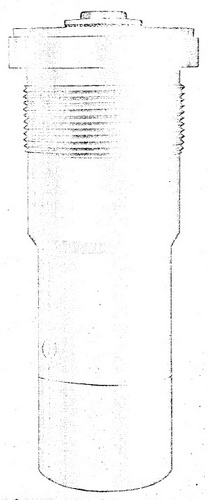|
|
| Fuzes for Rockets and Projector Charge |
| Chapter 9 |
| DECELERATION DISCRIMINATING BASE FUZES FOR FIN STABILIZED ROCKETS |
| Section B - Base Fuze Mk 166 Mod 0 (Pressure Arming, Deceleration Firing) |
| 1. General Data |
|
Used in: 5.0-inch Rocket Head Mk 2 Mod 2 (Common)1 |
|
Overall dimensions and weight of fuze: |
|
Length |
6.492 inches |
|
Diameter (maximum) |
2.475 inches |
|
Body threads |
2.125 inches – 12 NS-2 |
|
Weight |
3.90 lbs. approx. |
|
Applicable specification: OS 3906 |
|
General arrangement drawing: 562011 |
|
Sketch list of drawing & specs: 165443 |
|
Explosive components: |
|
A sensitive Primer Mk 102 (mercury fulminate primer mixture) located in the sensitive primer holder at the aft end of the detonator case. |
|
A Detonator Mk 33 Mod 1 (lead azide) located in the detonator case. |
|
Two detonator case lead-outs (tetryl) located in the detonator case. |
|
Two body lead-ins (tetryl) located in the body. |
|
Two body lead-outs (tetryl) located in the forward end of the body. |
|
A booster (approximately 28 grams tetryl) located in the magazine at the forward end of the body. |
| 2. Description |
|
General. Fuze Mk 166 is identical with Fuze Mk 162 except as noted under Function-ing Mechanism. Fuze Mk 166 Mod 0 is fires after the deceleration of the round has drop-ped to about 75 g. This corresponds to a distance of approximately 180 feet of unob-structed underwater travel when the striking velocity of the round is 1700 feet per se-cond. |
|
Figure 45 – Base Fuze Mk 166 Mod 0, External
View Full Size (approximately) |
 |
|
Use. Fuze Mk 166 is used in the 5.0-inch Common Fin Stabilized Aircraft Rockets (Complete Rounds) Mk 23 Mod 0 and Mk 23 Mod 1 (see OP 1415). The 5.0-inch Rocket Head Mk 2 is not considered to maintain the required stability after water or ground im-pact to assure reliable fuze action, therefore, new head designs are under development. |
|
Functioning mechanism. Fuze Mk 166 has the same functioning mechanism as Fuze Mk 162 except: |
|
1. The external configuration of the body differs in that the maximum diameter of Fuze Mk 166 is less than that of Fuze Mk 162, and the external body thread diameter is cor-respondingly reduced. |
|
2. Fuze Mk 166 utilizes a washer and an Inconel wire mesh combination as a gas chamber inlet filter whereas Fze Mk 162 untilizes an inlet shield and wire mesh combinat-ion as the filter. |
|
3. The baffle cup inlet orifice to the second stage of the pressure chamber is larger for Fuze Mk 166. The larger orifice promotes a reduced arming time which is in keeping with the higher velocity characteristics of the 5.0-inch round versus the 11.75-inch round. |
|
4. The creep force or air-drag force on the 11.75-inch Aircraft Rocket is much less than for the 5.0-inch High Velocity Aircraft Rocket. The sensitivity of Fuze Mk 166 must be reduced to compensate for this. The sensitivity is reduced by the addition of a slight shoulder on the forward inner diameter of the trigger block which increases the force neccessary to pull the trigger block off the firing pin lock balls. |
|
5. The 5.0-inch High Velocity Aircraft Rocket experience a larger deceleration under-water than does the 11.75-inch Aircraft Rocket. The trigger spring of Fuze Mk 166 is therefore stronger than the trigger spring of Fuze Mk 162. |
|
6. The detonator case explosive trains of the fuzes differ in that in Fuze Mk 166 the Primer Mk 102 replaces the Primer Mk 101 of Fuze Mk 162, and that no delay element is used in Fuze Mk 166. |
|
7. The firing pin of Fuze Mk 166 is a pointed stab type firing pin suitable for use with Primer Mk 102 rather than the round pointed firing pin used to initiate Primer Mk 101 in Fuze Mk 162. |
|
Figure 46 – Base Fuze Mk
166 Mod 0, Cross Section, |
|
|
| 3. Functioning |
|
Arming. The arming of Fuze Mk 166 is identical with Fuze Mk 162. The fuze will arm at from 450 to 580 feet from the launcher. |
|
Firing. As long as decelaration of the round is high, the inertia of the trigger block keeps the trigger spring compressed, but as soon as the deceleration is reduced below approximately 75 g, the spring overcomes friction forces and the inertia of the trigger block forces the trigger block to the rear off the firing pin lock balls. The balls thus re-leased move outwards and release the spring-loaded firing pin. The firing pin initiates the primer which in turn initiates the detonator and thus causes of the explosive train of the fuze and the explosive filler of the head. |
|
Acceptance test data. The acceptance plan and method of test are the same as for Fuze Mk 162. |
|
Sensitivity limits. Fuze Mk 166 should fire reliably on plate as light as ¼-inch mild steel at obliquities ranging from 0° to about 60°. |
| 4. Safety Features |
|
Same as Fuze Mk 162. |
| 5. Disposal and Servicing (Maintenance) |
|
Same as Fuze Mk 162. |
| 6. Installation Instructions |
|
Same as Fuze Mk 162. |
| 7. Packing and Marking. |
|
Same as Fuze Mk 162. |